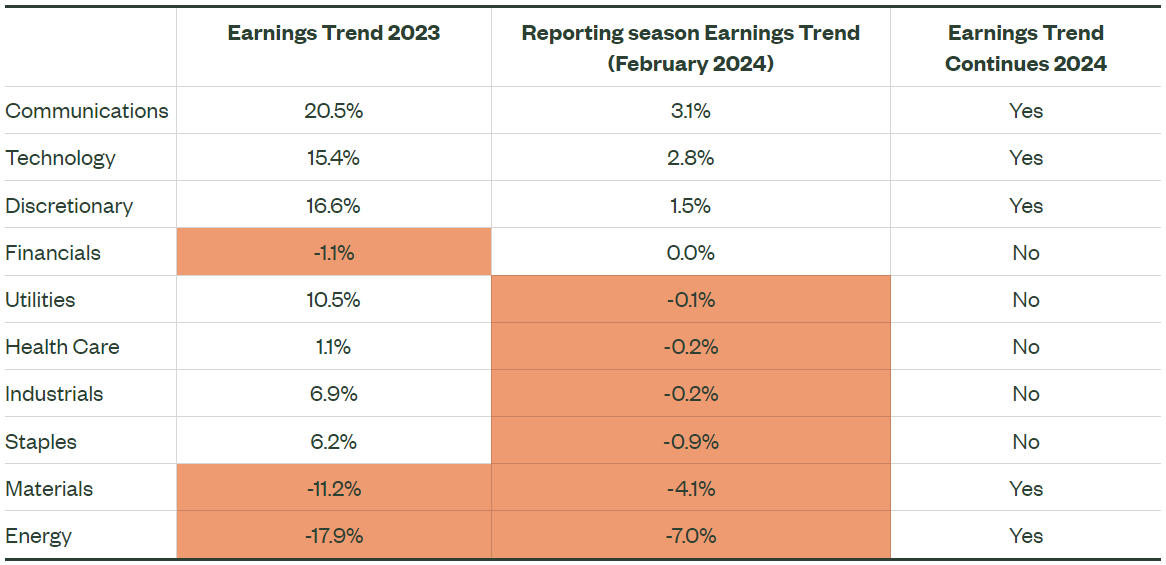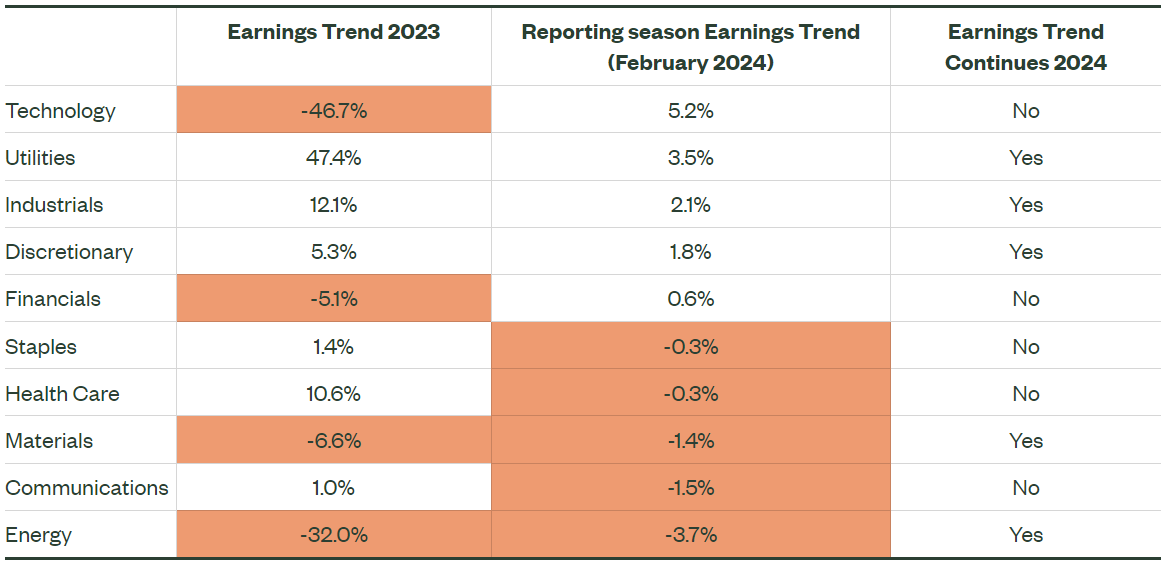The top 10 earnings revisions from reporting season (and 2 high performing sectors)
AI and technology continues to dominate global earnings trends
AI has been a dominate theme in 2023 and so far in 2024 this theme has continued to underpin positive earnings revisions across global markets. Without the positive earnings trends from AI and Technology companies the global markets would have seen negative earnings revisions in 2024 so far. As shown in Figure 1 the global communications sector has seen upgrades of 3.1% since the start of the year after seeing positive revisions of 20.5% in 2023. Similarly, Technology and Discretionary had powerful earnings revisions in 2023 and have seen further upgrades in 2024. In 2024 we have seen negative trends from almost every other sector with Energy seeing the biggest negative revisions.
Figure 1: MSCI World - Earnings Per Share (EPS) Trends – in 2023 and Reporting Season 2024

Source: FactSet, State Street Global Advisors as at 26 February 2024. The underlying earnings data is sourced from FactSet and represents market cap weighted returns and EPS for the representative indexes. EPS trends 2023 represent the % change in forecast EPS estimates for the next 12 months from 31 December 2022 to 31 December 2023. The Reporting season earnings trend represents the % change from in 2024 YTD to the 26 February 2024. Past performance is not a reliable indicator of future performance. Index returns are unmanaged and do not reflect the deduction of any fees or expenses. Index returns reflect all items of income, gain and loss and the reinvestment of dividends and other income as applicable.
S&P ASX 300 Index - Sanguine trend remains for broad market
As always the confession season provides a sanity check on earnings expectations for the next 12 months. In aggregate the Australian equity market as represented by the S&P ASX 300 Index seen a small -0.3% decline in earnings expectations during the February 2024 reporting season.
Market averages can be misleading and as shown in Figure 2, we have seen a wide range of outcomes across S&P ASX 300 sectors. The largest earnings upgrades have been observed in Technology where over the course of the February reporting season analysts have upgraded earnings estimates by +5.2% for the next 12 months (Note the negative trend in 2023). Utilities, Industrials and Discretionary have also seen positive improvements in the earnings expectations for the next 12 months. In contrast the Energy, Communications and Materials sectors have seen the largest downgrades. The contrast between the Australian and global communications sector is largely due the different make up of stocks – AI has yet to move the dial for large cap Australian communications. Financials faced headwinds in 2023 and have only seen very minor positive upgrades in 2024.
Figure 2: S&P ASX 300 Earnings Per Share (EPS) Trends in 2023 & During Feb 2024 Reporting Season

Source: FactSet, State Street Global Advisors as at 26 February 2024. The underlying earnings data is sourced from FactSet and represents market cap weighted returns and EPS for the representative indexes. EPS trends 2023 represent the % change in forecast EPS estimates for the next 12 months from 31 December 2022 to 31 December 2023. The Reporting season earnings trend represents the % change from in 31 January 2024 to 26 February 2024. Past performance is not a reliable indicator of future performance. Index returns are unmanaged and do not reflect the deduction of any fees or expenses. Index returns reflect all items of income, gain and loss and the reinvestment of dividends and other income as applicable. Earnings season is always a rich source of information for investors. While many focus on the reported results we are more interested in company forward guidance. As companies update investors on their operating environment and provide some guidance the investment analyst community adjust their forecasts for the company’s future earnings We can capture the changes in these trends by looking at the changes in the 12 month earnings per share forecasts.
The 10 most positive earnings reactions were diverse
Figure 3 below highlights some of the biggest reactions to the earnings announcements in February 2024. Of the top 100 companies, we highlight the top 10 companies in terms of the investors reaction to the result. This measure is designed to capture the market assessment of the information contained in the earnings release. Other key items beyond earnings may include company forward guidance, comments from management about the operating environment, competition, cash flow, dividends etc. It is also designed to capture the extent to which the market was surprised by the result. Companies with the largest positive surprises during reporting season came from a wide range of sectors and exhibited many different financial characteristics.
Figure 3: S&P ASX 100 - Top 10 positive earnings surprises during Feb 2024 reporting season

Source: FactSet, State Street Global Advisors as at 26 February 2024. We calculate an “earnings return” the return for the day of the earnings announcement. This information should not be used or construed as an offer to sell, a solicitation of an offer to buy, or a recommendation for any security. Past performance is not a reliable indicator of future performance. The stocks mentioned are not necessarily holdings invested in by State Street Global Advisors. References to specific company stocks should not be construed as recommendations or investment advice. The statements and opinions are subject to change at any time, based on market and other conditions.
Reporting season themes– High beta, low quality “junk” rotation
In Figure 4, we examine the S&P/ASX 300 universe to explore the themes that dominated during reporting season. We calculate average performance of various cohorts. Many of the characteristics we observed in February were consistent with investor preferences during risk on markets. Higher beta (more volatile) stocks outperformed lower beta (less volatile) stocks. Small capitalized stocks outperformed larger capitalized stocks. Lower profitability as measured by Return On Equity (ROE) outperformed more profitable companies. More leveraged as measured by Debt /Capital outperformed lower Debt/Capital. The most expensive companies with higher expected growth outperformed the cheaper lower growth names.
Short squeeze and reversal of trends from the last 12 months
Consistent with many reporting seasons we often observe a short covering rally in the most shorted securities. In February 2024 the most shorted securities outperformed the least shorted by +8.8%. This also lines up with a reversal of some of the “negative” momentum trades being unwound. We observed the stocks with the highest price momentum in the last 12 months underperform those with the lowest price momentum.
Figure 4: S&P ASX 300 - Thematic performance during February 2024 reporting season

Source: FactSet, State Street Global Advisors. Methodology: for each characteristic we sort from largest to smallest and calculate the average return for the top quintile (top 20%) of the stocks and the average return for stocks in the bottom quintile (bottom 20%) of stocks. The difference between top/bottom quintiles is shown in the last column. For example, we calculated the average return during Feb for the top 20% of stocks by market capitalisation (0.5% for large cap), the average return for the bottom 20% (6.3% for small cap), and the difference (-5.8%). On average, larger capitalised stocks underperformed smaller capitalised stocks. We apply this ranking and return calculations across the various financial metrics displayed. Past performance is not a reliable indicator of future performance.
Bottom line
The February reporting season has seen a wide range of results. The AI theme which dominated global markets has had less impact in the S&P ASX 300 index. The trend in Materials has remained negative while Financials saw only a very minor positive trend in February. The most interesting aspect of the reporting season has been the “junk” or “risk on” rotation. Small, higher beta, lower quality, and the most shorted securities outperformed.

10 stocks mentioned
1 fund mentioned

Bruce is Head of Active Quantitative Equity - Australia, for State Street Global Advisors. He has over 20 years' experience, covering Australian and global equites, long and short equities as well as global macro strategies.

Bruce is Head of Active Quantitative Equity - Australia, for State Street Global Advisors. He has over 20 years' experience, covering Australian and global equites, long and short equities as well as global macro strategies.
